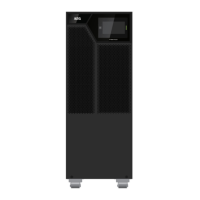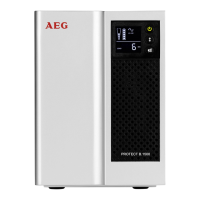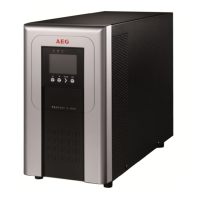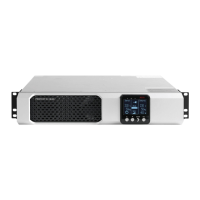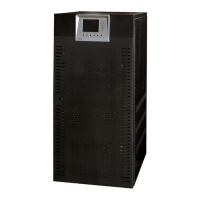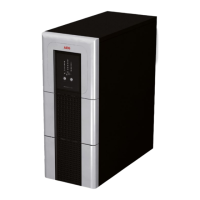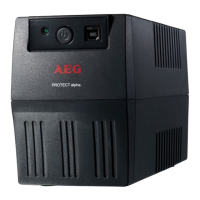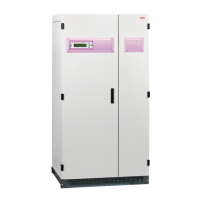
Do you have a question about the AEG Protect 5.31 Series and is the answer not in the manual?
| Operating Temperature | 0 - 40°C |
|---|---|
| Humidity | 0 - 95% non-condensing |
| Input Voltage | 230 V |
| Output Voltage | 230 V |
| Battery Type | Sealed lead-acid (SLA) |
| Communication Interface | USB |
| Safety Approvals | IEC/EN 62040-1, IEC/EN 62040-2 |
| Input Voltage Range | 160-276 VAC |
| Storage Temperature | -15 - 50°C |
Information duty for personnel working with the UPS.
Covers terms and conditions for claims and warranty rescission.
Highlights CAUTION, ATTENTION, NOTE and indented text for safety.
Mandates compliance with country-specific regulations and IEC 364.
Warns of fatal voltages and damage from improper work or parts.
Defines personnel requirements and authorization for UPS work.
Emphasizes personnel responsibility and observation of safety procedures.
Defines intended use and conditions for the UPS operation.
States no liability for unintended applications or owner responsibilities.
Details the electronic components, suitability for universal applications, and reliability.
Describes the arrangement of operating elements, components, and individual PCBs with open door.
Explains how UPS units are packed for transport and notes on protective film removal.
Provides instructions and cautions for transporting the UPS unit by crane.
Specifies suitable floor surfaces and environmental requirements for UPS installation.
Lists and describes the four possible operating modes of the UPS.
Explains the function of load interrupter switch Q1, manual bypass Q29, and inverter contactor K7.
Details the function of the SBS control unit and its role in load switching.
Describes battery charging process, including constant and trickle charging.
Details how to initiate and display results of implemented battery tests via DOU.
Identifies terminal strips X1, X4 for supply, X2 for battery, and X3 for loads.
Illustrates connection panels and emphasizes correct polarity for mains, load, and battery cables.
Provides a table of wire cross sections and fuse ratings for various connections.
Lists steps for preparing the UPS for start-up, including switch positions and measurements.
Details the step-by-step procedure for starting up the UPS, including LED and display indications.
Provides a step-by-step guide to safely disconnect the UPS from the power supply.
Outlines the procedure to restart the UPS after it has been disconnected from the power supply.
Explains how to properly shut down the UPS system, emphasizing capacitor discharge.
Lists fuse ratings and protected components for the UPS system.
Introduces the DOU, its components (display, LEDs, keys) and purpose.
Explains the meaning of LED indicators (red, yellow, green) and the acoustic signal generator.
Describes operation using ENTER and display keys, including switching converters and acknowledging faults.
Presents the overall menu tree structure for navigating the UPS system settings.
Describes the main menu as the highest level for accessing submenus and settings.
Explains the operating display showing unit status, measured values, and key assignments.
Details accessing menus for circuit, battery, and load statuses and measured values.
Covers setting parameters like LCD contrast, language, real time, and acoustic signal generator.
Details accessing the service menu for setting battery parameters and operating statuses.
Explains how to use the Help menu to look up keyboard symbol meanings.
Provides instructions for battery handling and charging using the DOU interface.
Details battery parameters that can be set and lists parameters for lead-acid and NiCd batteries.
Explains how to initiate battery tests, set parameters, and view results via the DOU.
Describes remote signalling PCB inputs/outputs and terminal assignments for status monitoring.
Details the two separate serial interfaces for IT connections and optional protocol selection.
Explains how diagnostic functions increase reliability and reduce troubleshooting time.
Lists common faults, their possible causes, and recommended remedies.
Provides step-by-step instructions for removing and installing UPS fans.
Recommends regular visual checks and functional tests to maintain availability and reliability.
Outlines what to check during visual inspections for mechanical damage, dust, and foreign bodies.
Describes weekly checks and three-monthly/annual measurements for battery health.
Recommends stocking spare parts for permanent operational availability.
Illustrates PCBs on the control unit pivot plate and lists optional/standard components.
Shows PCBs on the control unit pivot plate and provides a legend for their designation.


